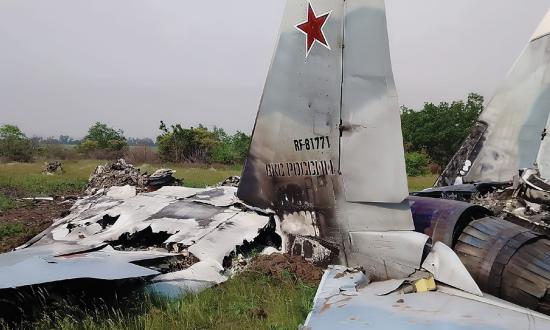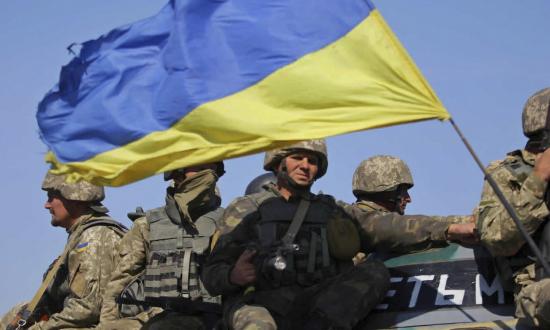“We’re here,”my guide Sasha said, jumping out of the passenger seat ahead of me as our car stopped rolling. I could tell he was ecstatic to show me the site. A few steps from the car, his Kevlar-clad torso disappeared through an opening in the half-bombed-out building. I followed.
We were on the Ukrainian frontline, in a town just behind Bakhmut. I was paying my first visit to an intelligence watch floor in the country. But in the dark, I found just Sasha and one soldier. They were lighting cigarettes and laughing, catching up in Ukrainian. The room was big but nearly empty. A few crated supplies lined the walls, and a bare plyboard table took up the middle of the room.
“This is it?” I asked. I knew the Ukrainians had limited resources for their command, control, communications, computers, and intelligence (C4I) infrastructure—in fact, I was here to see if the nongovernmental organization (NGO) I was working with could raise funds to help equip them—but I assumed their intelligence watch floor would be just a more rugged version of ours. Maybe fewer monitors and no expensive KVM switches?
“Oh no,” Sasha said, smiling. He gestured to a nondescript doorway covered by a curtain. He looked amused. Through the curtain, I found the real watch floor.
The room was invisible to Russian targeting. There were no antennas visible from the outside. Inside, the building felt abandoned. But in this windowless inner sanctum, a handful of men—fewer analysts even than in a crammed U.S. Navy supplementary or expeditionary intelligence plot—fused live information coming in from combat up and down the line. Flags and unit patches lined the cement walls. A few rifles lay in a corner next to custom drone attachments and a coffee station. The watch floor conducted its mission with just a handful of laptops, a few monitors, and a Starlink terminal to provide connectivity. When they told me they were responsible for a very large area of Ukraine’s frontline, I wondered aloud how so few soldiers could track that entire area of responsibility. Their leader, a sergeant, explained that they were just one component of a disaggregated battlespace awareness center. They did not operate alone. They moved frequently and stayed disaggregated. In the parking lot, their nondescript vehicles sat ready to relocate them at a moment’s notice.
I’m a U.S. Navy intelligence officer now in the reserves while I attend graduate school. Even though I left active duty a year ago, I still see the world through the lens of my 1830 training and experience. Four lessons from my time in Ukraine apply directly to naval warfighting. First, countertargeting is an essential competency for all units. Second, effective platforms are either very survivable or very attritable; anything in the middle becomes covered in ash or irrelevant. Third, operational and even tactical units need organic information warfare capabilities: electronic warfare, unmanned intelligence, surveillance, and reconnaissance (ISR), propaganda, and more. And fourth, leadership in a warzone is tougher than I expected.
Countertargeting
Just as Ukrainian units work to blend into their surroundings, so must U.S. Navy units continue to perfect emission control (EmCon) and understand how adversaries target them. Every Ukrainian unit I visited—especially when the unit operated a node worthy of a Russian missile—blended seamlessly into the background. When large groups assembled, cell phones were turned off. When armored vehicles parked, overhead cover disguised them. When drones flew reconnaissance missions, their pilots stayed hidden.
This task is much easier in urban warfare than in naval surface and air operations, despite the vastness of the blue water. EmCon, deception tactics, and distributed operations will be the building blocks that preserve the naval force. These tactics should become even more ingrained in U.S. warfighting culture. A healthy reliance on the undersea fleet also will be necessary. Good tactical situation (TacSit) management—i.e., not giving the adversary target-quality data—will mean survival.
Survivable-Attritable Spectrum
The Ukrainian frontline paints a stark picture of effective warfighting once targeted, especially during offensive operations when units must sacrifice their TacSit to hold at risk the enemy. In these conditions, the most effective units are either very survivable—a tank, for example, draws fire, withstands hits, and keeps fighting—or very expendable, like cheap drones. Platforms in the middle ground, lacking either the resilience to survive attacks or the disposability to risk and attrite, quickly become burdens.
At every stop I made, Ukrainian units requested three things from the NGO I was supporting: night vision, drones, and used cars. Night vision makes infantry more survivable. Drones, like the cheap Mavic-3, are the ultimate expendable platform. Used cars, however, were a surprise. Ukrainian troops use them to get to their positions, sometimes driving 100-mph through a field to get to the next tree line where their squad is dug in. If they drive any slower, they will be targeted by a Russian drone, RPG, or worse. A hundred-soldier unit could lose a dozen cars in a week.
Even if they have Humvees, mine-resistant ambush-protected vehicles (MRAPs), or anything with armor, Ukrainian forces rarely risk using these platforms, because they expect they will need them later. This hesitation to use armored vehicles—President Volodymyr Zelensky urgently requested them, alongside tanks, air defense, and F-16s—also surprised me. But while the vehicles increase the survivability of the infantry they carry, they also stand out as targets to the Russians. The Ukrainians lack spares, or even a fully mechanized force, so they hesitate to risk armored vehicles day-to-day. Were more-mechanized soldiers fighting, complemented by other capabilities and tactics, as in our force, the armored-vehicle backbone could prove effective.
This situation does not yet call for a rethink of U.S. Navy force structuring or asset deployment tactics, but it is a useful lens. If AEGIS systems afloat work as well against People’s Liberation Army ballistic missiles as Patriot missiles have against Russia’s best strike capabilities, then U.S. carrier strike groups and surface units could be survivable in a future conflict. The littoral combat ship does not need another obituary here, but it is an example of a unit that would be neither survivable, because of weak air defense, or attritable, given its crew and price tag.
The importance of having attritable units cannot be overstated. The U.S. Navy is developing some, but today it would fight with largely survivable units. Attritable units, most of them unmanned, are now part of every Ukrainian and Russian unit. Drones have struck far behind the lines on both sides, and Ukrainian drones have helped sink some of Russia’s mightiest warships in the Black Sea. When the Russians gain ground offensively, it is because they use many thousands of expendable soldiers—something a democracy will not do.
Organic Information Warfare Capabilities
Alongside both expendable platforms and survivable ones, forces need organic information warfare capabilities at the unit level. Ukrainian fighters understand this imperative. In fact, many units pool 10 percent of the soldiers’ wages—similar to U.S. wardroom dues—to purchase drones. Ukrainian units that do not have their own ISR are not combat effective.
The lesson for the U.S. Navy is clear. Aircraft carrier strike groups, with their nearly 100 air-breathing assets, must stop relying on shore-based maritime patrol aircraft and quickly obtain the ability to fly their own unmanned surveillance. Developing and operationalizing unmanned ISR capability is complex for naval warfare’s vast distances, but Ukrainian experience suggests that organic ISR will become a life-or-death issue. It could be the difference between U.S. surface units surviving or not.
Ukrainian units also need their own electronic attack capabilities. They require frequency-hopping kit for their communications and drones, among other information warfare capabilities. On land, Ukrainian units conduct social media campaigns to raise money and buy more drones. At sea, distributed U.S. Navy ships will need reliable organic weather data, above and under the sea. Too many of these capabilities—especially unmanned ISR—sit in specialized units operating independently from strike groups and other operational units.
These lessons are not new. The U.S. Navy has deep thinkers and innovative, tech-savvy tacticians who understand the essential role of countertargeting, the survivable-attritable spectrum, and the need for organic information warfare. Distributed maritime operations (DMO) guides warfighting toward many of these practices. However, these lessons from Ukraine can give U.S. units conviction as they train and equip to operationalize DMO.
Scrapping a platform because it is not survivable enough is a tough call. Training a tired destroyer crew with yet another electromagnetic maneuver warfare exercise can feel repetitive and wear down morale. Lighting a fire under the chairs of procurement bureaucrats to accelerate delivery of unmanned ISR to aircraft carriers will be a fight. The technology will evolve faster than the bureaucracy around it. These lessons from Ukraine are bought in blood and cannot be ignored.
Wars Don’t Bring People Together, Tenacious Leaders Do
Last, and hardest, are the leadership lessons. Often in Ukraine, I thought back to Joe Rochefort’s War: The Odyssey of the Codebreaker Who Outwitted Yamamoto at Midway (U.S. Naval Institute Press, 2013). Rochefort and his cryptologists broke the Japanese codes and helped the U.S. Navy to win the battle of Midway. However, internal Navy politics nearly prevented senior admirals from listening to Rochefort’s intelligence. Later, these same forces removed Rochefort from his role and sidelined him for the rest of the war. Despite the existential war with Japan, the U.S. Navy was not unified.
Two years into war, the Ukrainians are tired. The fatigue came as no surprise to me when I arrived, but something else did. Every person seemed to have his or her own motivation. There are many Ukrainians driven by patriotism, duty, and hope. But there are men and women who have other priorities: family, business, ego, politics, money, etc.
At first, I was disappointed. I assumed distractions such as office politics would fade in an existential war. But in some cases, the distractions become worse. Just as internal politics made the Navy less effective in World War II, the Russia-Ukraine war is a painful, tedious marathon first and a unifier second. It is an existential leadership challenge. The Russian adversary does help unify the population—to a point. But the real unifiers for Ukraine are its tenacious leaders.
In our own divided nation, it will not be an easy decision for our leaders to fight an existential war. It will not be easy for the military. A leader’s ability to unify his or her team behind a common purpose is the most lethal organic capability and must be embodied in every commander, on every deckplate, and throughout every chief’s mess. Our Ukrainian brothers and sisters have learned this and many other lessons in blood. Let us not learn them again.
Key recommendations:
Countertargeting
- Continue thorough EmCon- and TacSit-focused training
- Ensure countertargeting becomes instinctive for intelligence professionals and command-track line officers
Survivable-Attritable Dichotomy
- Assume that, once targeted, units stay relevant only if they are survivable or attritable
- Evaluate U.S. Navy force structure through this lens, scrapping platforms that are neither, or sending them to secondary theaters
- Proliferate expendable platforms throughout the fleet
Information Warfare Capabilities
- Equip all units with organic ISR, preferably unmanned so it is expendable
- Evaluate at what level each of the information warfare community’s many capabilities are held and whether they are needed at a lower level
Leadership
- View everyday stressors as opportunities to hone leadership
- Assume these same stressors and many others will be more severe in wartime
- Instill historical lessons—an objective of the Chief of Naval Operations’ reading list—to avoid relearning those bought with blood






